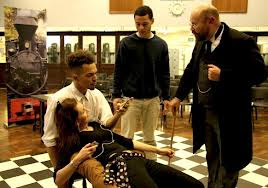The M Word
Somewhere along the way, rote learning got a bad rap. Memorisation (there, I said the M word) became anathema to learning. How this came to be, I am uncertain, but what I am certain about is that this shift away from memorisation has undermined the effectiveness of the teaching and learning process.
The total emphasis on critical thinking has it wrong: Before students can think critically, they need to have something to think about in their brains. It is true that knowledge without comprehension is of little use, but comprehension requires knowledge and it takes time and effort to acquire.
Bloom's Taxonomy maintains that the highest order of thinking occurs at the evaluating and creating levels which infer that the thinkers must have knowledge, facts, data, or information in their brains to combine into something new, or with which to judge relative importance or value. Therefore, effective knowledge acquisition has to come first.Students deserve to know how to learn and teachers do them a disservice when they do not teach them useful learning skills. Here are some underlying concepts that need to be accepted before we can continue:
The brain is a learning tool. This might seem obvious, but the brain is not a passive sponge. It requires active effort to retain information in short-term memory and even more effort to get it into long-term memory.
Learners need to know that the longer an idea can be kept in short-term memory, the more chance it can be pushed into long-term memory. This is where practice makes perfect makes sense.
The body is another learning tool -- another often-ignored concept. The body is connected to the brain and if you engage the body, you are engaging the brain too.
Learners feel an addictive sense of accomplishment when something has been memorised completely.
With these concepts in mind, I would like to share some of the memorisation learning methods that make it effective and enjoyable:
Learning Aloud
Just as we use our mouths to repeat a phone number over and over to retain it in short term memory, other things can be learned in the same way. One key point here to remember is that the cycle of repetition must be short and quick and no less than three times..
Using Rhythm and Breath
Learning text is done quickly, but since the order of learning the words is important there are some effective ways to chain them together. Learn the passage in breath groups, or what can be comfortably stated in one breath. Students using their mouths, because it is part of the body and a learning tool, repeat the breath group until it is firmly in short-term memory, then go on to the next breath group and do the same. When that is done, put both groups together and repeat them.
This is best taught to students using choral repetition. The key here is to be enthusiastic and energetic, praising the students as they practise. Printing the first letter of each word in the breath group can help students remember the words as they learn them.
Jigsaw Strategies
A creative teacher can have groups of students learn different parts of the passage and then switch parts, or stand up as they say their passage, or even move to a different part of the room with each phrase. Since the body is connected to the brain, it is effective to have students do a hand signal or body movement to symbolise the content of the breath group as they say it.
Sometimes it is helpful to start at the end and add phrases in reverse order known as reverse chaining. Its also effective to have the students perform the action of the words they are trying to learn as they told a story.
Memorisation is not a bad thing. Students have to memorise the alphabet, sight words, vocabulary, times tables, and many other things and have fun doing it.
There's countless ways to help students learn how to memorise quickly, efficiently, and enjoyably. You can use music, song, dance, rhythms, patterns, competitions, and games. Once they know how to learn, or memorise, then students can acquire knowledge about anything they want to learn, which is in direction opposition to what critics say about rote memorisation.
The other great thing about learning a poem or piece of prose by heart is that inevitably there are new words to learn and understand, so vocabulary extends almost without effort. And such words are often imbued with the meanings and feelings felt by the reader as they become acquainted with the text and thus carry extra power. There is also a wonderful confidence that comes with the certainty of the learnt text.

I am reminded of our Youth Theatre who did a great production of A Midsummer Night's Dream a few years ago under the excellent direction of Natalie Smith and Andy Rogers. It was interesting to watch the group of 30 or so young people balk at the idea of Shakespeare and to recognise their fear of speaking this 'funny' language that they said they did not understand. And then gradually over a period of about 3 months to see their confidence rise as they learnt their scripts, and by inhabiting them physically gained a greater understanding of meaning. The final performance was very special. It was great to hear the text flow out with ease and clarity of meaning and connection. Here we had 30 young people from Barking and Dagenham who had not only learnt the text, but through the process had come to understand and love it and by the end were able to say honestly that they thought Shakespeare was writing about them! And of course he was.










































